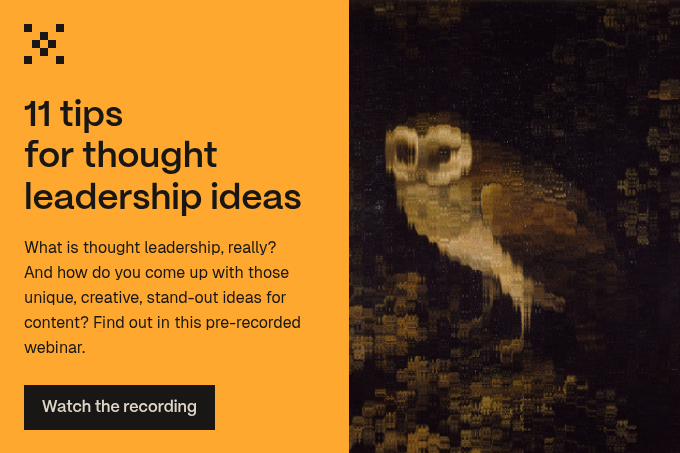Almost 60 percent of survey respondents read one or more hours of thought leadership content per week. Fifty-five percent of these people state that they use this information to vet organisations.
It's no wonder, then, that thought leadership is a common thing we get asked to do at Articulate.
It's an interesting area of marketing, so we're going to share some thoughts and tips about how to do it right.
Let's get stuck in.
What is thought leadership?
We refactored our purpose at the beginning of the year. We sat down and asked ourselves, what is Articulate for? And what do we do?
This is Articulate's purpose.
-1.jpg?width=800&name=Screenshot%20(262)-1.jpg) We're informing people. We're helping them understand their world and make better decisions. We're creating an open channel for communication so that people can engage with us. And we want to inspire positive change.
We're informing people. We're helping them understand their world and make better decisions. We're creating an open channel for communication so that people can engage with us. And we want to inspire positive change.
Thought leadership has the same kind of intention. It too is about informing, connecting, and inspiring.
It's a way of demonstrating what you know, what your expertise it, and what you do as a business. That way, you stake a claim.
Why should you 'do' thought leadership?
Coming from a marketing perspective, thought leadership is part of the toolkit of content that attracts, converts, and closes customers through your website and through your various digital channels.
It can also help you cut through the noise.
I started blogging in 2006. My blog was called Bad Language and it got about 50,000 visitors a month in about six months, because there just wasn't a lot of blogging going on. But finding an audience and cutting through the noise is much harder now. You have to have more value. Your stuff has to be better.
That's why thought leadership feeds into our marketing model. It offers competitive differentiation.
Thought leadership doesn't have to be big, or complex, or clever. You don't have to write PhD thesis-length articles to be a thought leader. In fact, I would argue, probably that's not the way to do it. If it's long, complicated, technical, you're not going to do it. It's going to take you a year to get this sort of laborious process complete. And then nobody's going to read it.
Instead, you need to think like a performer. You need an audience, and you need to keep them interested. It's about stepping down your expertise in a way that is useful, relevant, and interesting for the person consuming it.
.png?width=821&name=Screenshot%20(264).png)
How do you become a thought leader? (It's easy)
I heard this phrase from a comedian when I was a young man: 'Your obvious is your talent'.
She was talking about stand-up comedy. But it's true for thought leadership as well.
If you have spent a career doing something, five years doing something, a year thinking about something, a month researching something, you are an expert. You're already qualified to do thought leadership.
4 adoptable examples
So where does thought leadership come from? Here are some examples of thought leadership:
1. Articles
At Articulate, we write a lot of content about how we work as a business, because we're a B Corp and we want to share what a good working environment looks like.
We've worked remotely for over 15 years, so when the pandemic came we put a lot of free content out, just to try and help people adjust to remote work.
On top of this, we obviously publish a lot of blog posts about SEO and content copywriting, and here I am talking about thought leadership. So, as we learn our craft and advance the state of the art within Articulate, we tend to share that information freely.
2. Webinars

It's very easy to set yourself up to do webinars on Zoom. You can do the registration and the reminder email all in the Zoom platform. It's 30 or 40 quid a month.
We do all the signups, landing pages and reminder emails in HubSpot for good and sufficient reasons. And we just use Zoom for the broadcast bit. I use Pasteapp to put together the slide decks.
So, to do webinars, all you have to do is bring your ideas, talk about something you know about, throw together a presentation, and voila!
3. YouTube videos
Let's talk about an Articulate favourite: Layla Pomper. If you use ClickUp, or if you're in any way interested in project management and process-ification, checklists and organising and structuring your business in a logical way, she's your woman.
She's a genius, not only at ClickUp, but also at using YouTube. And it gets her a lot of attention. She's got thousands of YouTube subscribers to her YouTube channel. Her business model is: you Google an answer about ClickUp, you find her, you watch the video, you realise she's a genius and she knows what she's talking about, and then you book up some training.
We've followed that path and she's brilliant.
.png?width=821&name=Screenshot%20(266).png)
4. White papers
You can also do the traditional white paper thing. We do a lot of this for our clients.
This piece of content sits behind a landing page, but it doesn't have to. Our best converting offer on Articulate is actually a 7,000-word blog, but you can download it as a PDF if you want to. This has the potential to convert better than a landing page.
Because it's valuable content. People can see what they want and see what they get. The offer with that blog is, is not, 'Hey, there's something here. We're not going to tell you what it is until you give us your details.' It's more like, 'This is a bit difficult to read in blog format, here's another way.' Or, 'You might want to take this away and read it on your Kindle later. Get it as a PDF.' So we're offering convenience rather than mystery.
Thought leadership tips for beginners

I can't tell you how to do your thought leadership. But I can talk about how to present it, structure it, get credibility, and build authority. That's really the difference between a thought leadership piece of content and an SEO or top-of-funnel piece. It's all about authority.
With that in mind, here are six tips to consider:
-
Create thought leadership content frequently, regularly, and consistently. Pick a format you're good at, create regularly, and stick at it.
-
If you want to make everybody happy, you'll end up pleasing nobody. You definitely won't stand out. Being controversial doesn't suit everybody, but you don't have to be bland. And thought leadership requires staking a claim.
-
Avoid bad writing like the plague. I'm a writer. I'm obviously very concerned about things like poor openings, long blocks of unsegmented text, lack of credibility, waffle. There are lots of things that we stamp on when we edit clients' writing, and they don't quite know what we've done. And they think it's wordsmithing, but it's actually editing. That's quite important.
-
Add diagrams. A picture really is worth 1000 words. We really like Whimsical. You create neat-looking, well-organised diagrams very, very quick.
.png?width=819&name=Screenshot%20(265).png)
-
Break up your information. If you're writing white papers or blogs, use different layouts, headings, bullet lists and so on. This makes the information easier to consume without changing what you're saying.
-
Open with a few facts or a quote. This always establishes credibility.
Go forth, future thought leaders
We hope you've found this advice on thought leadership useful.
The only thing to do now is practice - take your expertise, spruce up your creative skills, and start sharing valuable content. Who knows where it might lead you, or who you might influence.
'If you can inspire positive change, if you can share some insight, some technique, some process, some knowledge, some opinion that allows people to see the world differently, to do something differently, to change the way they work or solve their problems, that's very inspiring.'
— Matthew Stibbe, CEO at Articulate Marketing






